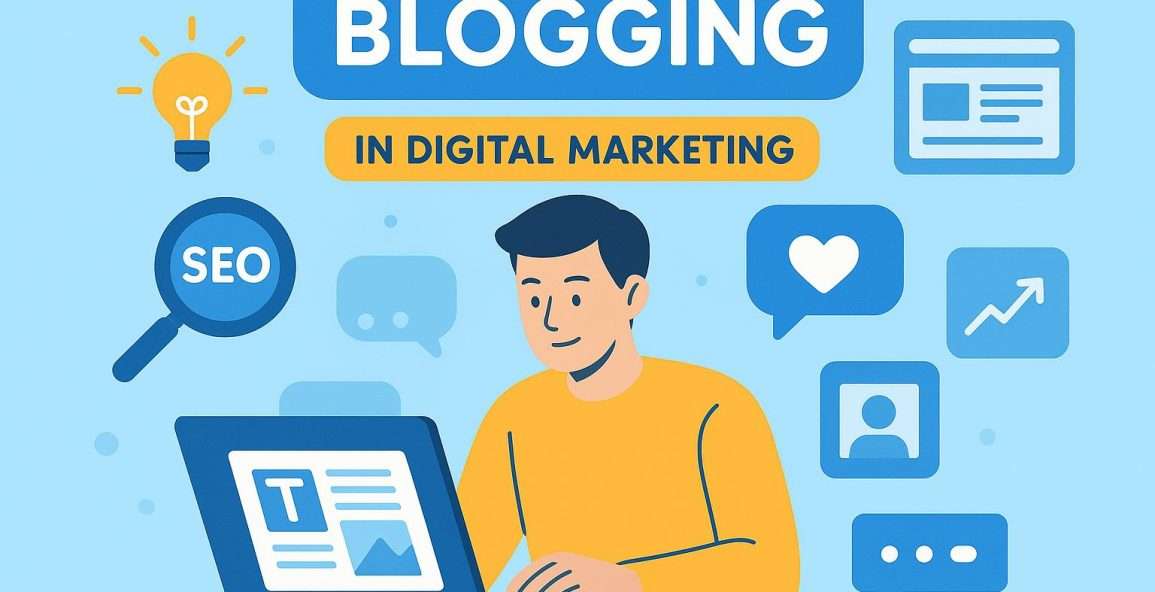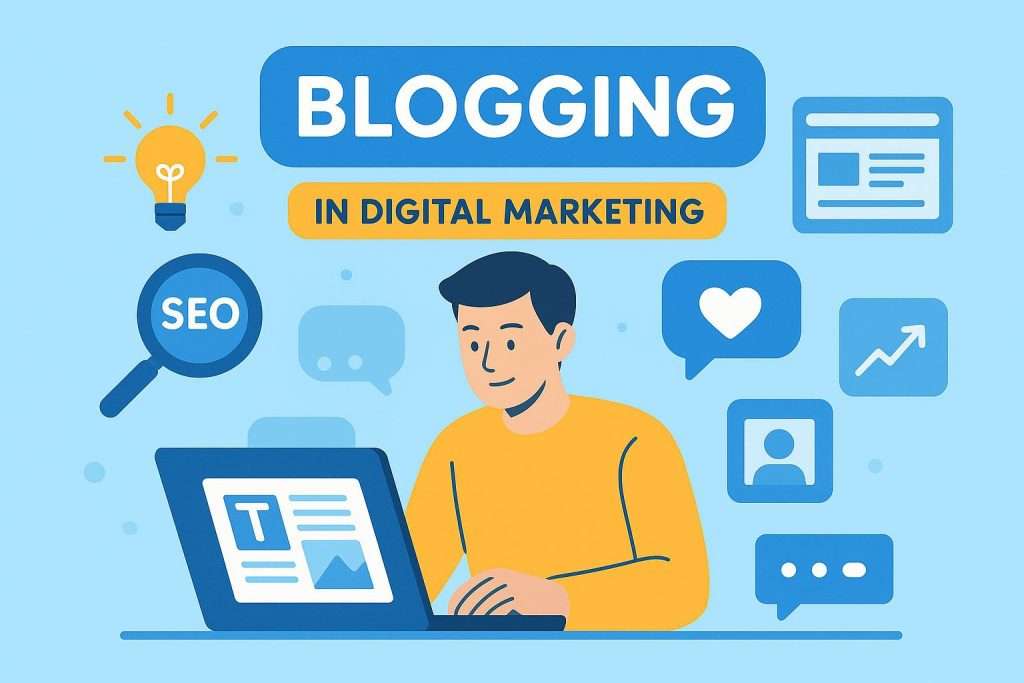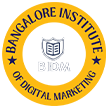
In the fast-evolving world of digital marketing, blogging has emerged as one of the most powerful tools to engage audiences, drive traffic, and establish brand authority.
But what exactly is blogging in digital marketing, and why has it become so essential for businesses of all sizes? This article delves deep into the concept of blogging, its benefits, strategies, and how it can transform your digital marketing efforts.
Table of Contents
Understanding Blogging in the Digital Marketing Context
Blogging is more than just writing posts or sharing updates online. In digital marketing, it serves as a strategic tool to connect with your target audience, enhance search engine visibility, and foster relationships that translate into business growth. At its core, blogging in digital marketing involves creating informative, engaging, and value-driven content tailored to your audience’s needs and interests.
Unlike traditional advertising, which interrupts users with promotional messages, blogging focuses on providing value. It educates, entertains, and informs readers, building trust and credibility over time. In this sense, blogging is an inbound marketing strategy that attracts potential customers rather than pushing messages at them.

The Role of Blogging in Digital Marketing
Blogging plays multiple roles in a comprehensive digital marketing strategy. Understanding these roles helps businesses leverage blogging effectively to meet marketing objectives.
Enhancing SEO Performance
One of the primary benefits of blogging in digital marketing is its impact on search engine optimization (SEO). Every blog post you create is an opportunity to rank for specific keywords related to your industry, products, or services. Optimized content can drive organic traffic from search engines, increasing visibility and bringing potential customers to your website.
Moreover, blogs allow for internal linking strategies, which help search engines understand your site structure and content hierarchy. This can improve the overall SEO health of your website, leading to higher rankings in search results.
Building Brand Authority
Consistently publishing high-quality, informative blog posts establishes your brand as an authority in your niche. When readers find valuable insights in your content, they are more likely to trust your brand and consider your products or services when making purchasing decisions.
Authority-building is not just about sharing knowledge; it’s about offering unique perspectives, backed by research, data, and actionable insights. This positions your business as a go-to resource for industry-related information.
Engaging and Retaining Customers
Blogging enables you to engage with your audience in a meaningful way. By addressing their pain points, answering questions, and providing solutions, you create a relationship that goes beyond a mere transactional interaction.
Engaging content also encourages readers to spend more time on your website, increasing the likelihood of conversions. Interactive elements like comment sections, polls, or embedded videos can further enhance engagement and create a sense of community around your brand.
Supporting Social Media and Content Marketing
Blogs provide content that can be repurposed across social media platforms, newsletters, and other marketing channels. Sharing blog content on social media drives traffic back to your website and extends your reach to new audiences.
Additionally, blogs can serve as the foundation for content marketing campaigns, providing material for email marketing sequences, lead magnets, or downloadable resources that nurture potential customers through the sales funnel.
Driving Lead Generation and Sales
While blogs are primarily educational, they also play a crucial role in lead generation. Well-crafted blog posts often include calls-to-action (CTAs) that guide readers to take the next step, such as subscribing to a newsletter, downloading an ebook, or requesting a consultation.
Over time, these leads can be nurtured into paying customers. Blogging, therefore, acts as a bridge between awareness and conversion in the digital marketing journey.
Key Components of an Effective Blog in Digital Marketing
Creating a successful blog requires more than just writing long posts. There are several components that contribute to a blog’s effectiveness in digital marketing.
Audience-Centric Content
Understanding your audience is the cornerstone of effective blogging. Content should be tailored to address the specific needs, interests, and challenges of your target audience. Conducting audience research, creating buyer personas, and analyzing search intent are essential steps in crafting relevant content.
Keyword Optimization
Keywords are the foundation of search engine visibility. Identifying and strategically incorporating the right keywords into your blog posts ensures that your content reaches users actively searching for information related to your niche. Keyword research tools like Google Keyword Planner, SEMrush, or Ahrefs can help identify high-value keywords.
Compelling Headlines
The headline is the first thing readers see, and it determines whether they click on your blog post. A compelling headline should be clear, concise, and convey the value of the content. Using numbers, questions, or power words can enhance click-through rates.
Quality and Originality
High-quality, original content is non-negotiable in blogging. Search engines prioritize content that provides unique insights and demonstrates expertise. Avoid duplicate content, thin posts, or generic information that doesn’t offer real value to readers.
Visual and Interactive Elements
Incorporating images, infographics, videos, and interactive content can enhance the reader experience. Visual elements break up large blocks of text, make complex information easier to digest, and increase engagement metrics like time on page and social shares.
Internal and External Linking
Linking to other relevant pages on your website improves site navigation and SEO, while linking to authoritative external sources adds credibility and trustworthiness to your content. Proper linking strategies enhance both user experience and search engine ranking.
Readability and Structure
A well-structured blog post with clear headings, subheadings, and short paragraphs is easier to read and more likely to retain the audience’s attention. Tools like Hemingway Editor or Grammarly can help ensure content is readable and error-free.
Types of Blogs Used in Digital Marketing
Blogs can serve different purposes in digital marketing, depending on your goals and audience needs. Here are the most common types of blogs used:
Educational Blogs
These blogs aim to teach readers something valuable. They often include how-to guides, tutorials, or step-by-step instructions. Educational content positions your brand as a helpful resource and builds trust with your audience.
Industry News and Trends
Blogs that focus on industry news, updates, and trends help keep your audience informed and position your brand as a thought leader. These posts demonstrate that your business is knowledgeable and up-to-date with the latest developments in your field.
Opinion and Thought Leadership Blogs
These posts share expert opinions, insights, or perspectives on industry-related topics. Thought leadership blogs help establish your authority, differentiate your brand, and attract readers who value informed viewpoints.
Case Studies and Success Stories
Case studies showcase real-life examples of how your products or services have solved problems for clients. They provide social proof, highlight the value of your offerings, and can influence purchasing decisions.
Listicles and Curated Content
List-based blogs, or listicles, are highly readable and shareable. Curated content, which aggregates relevant information from various sources, can also provide value while saving your audience time.
Steps to Create a Successful Blog in Digital Marketing
Creating a blog that drives results requires a systematic approach. Here’s a step-by-step guide:
Conduct Audience Research
Identify your target audience’s demographics, interests, and challenges. Understanding their needs will help you create content that resonates.
Perform Keyword Research
Use keyword research tools to find topics your audience is searching for. Focus on long-tail keywords that reflect search intent and have moderate competition.
Plan Content Strategy
Develop a content calendar outlining blog topics, publishing frequency, and target keywords. Planning ensures consistency and alignment with your overall marketing goals.
Write High-Quality Content
Craft informative, engaging, and well-structured content. Ensure that your posts are original, accurate, and provide actionable insights.
Optimize for SEO
Incorporate keywords naturally into your content, meta descriptions, headings, and image alt texts. Optimize page load speed, mobile-friendliness, and internal linking.
Include Visuals
Add images, charts, infographics, and videos to make content more appealing and easier to understand.
Promote Your Blog
Share your blog posts on social media, email newsletters, and other marketing channels. Consider influencer collaborations or guest blogging to expand your reach.
Measure and Analyze Performance
Use analytics tools like Google Analytics or SEMrush to track metrics such as page views, bounce rate, time on page, and conversions. Analyzing performance helps refine future blog strategies.
Common Mistakes to Avoid in Blogging for Digital Marketing
Even experienced marketers can fall into common blogging pitfalls. Avoiding these mistakes ensures your content achieves its intended impact:
- Ignoring audience research and writing content without understanding readers’ needs.
- Focusing solely on keywords rather than user intent and value.
- Producing low-quality, thin, or duplicate content.
- Neglecting SEO best practices like meta tags, alt texts, and internal linking.
- Publishing inconsistently without a content calendar.
- Overlooking promotion and distribution, assuming readers will find your content organically.
The Future of Blogging in Digital Marketing
Blogging continues to evolve with changing technology and user behavior. Voice search, AI-driven content, and interactive formats are shaping the future of blogging. Businesses that adapt to these trends and maintain a focus on high-quality, audience-centric content will continue to benefit from blogging as a cornerstone of digital marketing.
Conclusion
Blogging in digital marketing is more than a content creation exercise; it is a strategic tool that drives traffic, builds authority, engages audiences, and generates leads. By understanding your audience, creating high-quality content, optimizing for SEO, and promoting your posts effectively, you can harness the full potential of blogging to achieve your business goals.
The power of blogging lies in its ability to educate, inform, and inspire action. In a digital landscape crowded with noise, consistent and valuable blogging sets brands apart and fosters long-term relationships with audiences.
Investing in a well-planned, well-executed blog strategy is not optional; it’s a necessity for businesses aiming to thrive in the competitive world of digital marketing.



